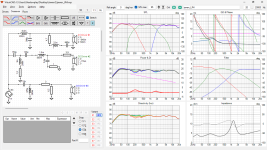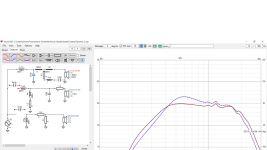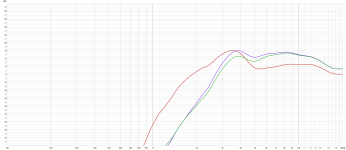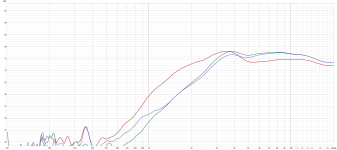Hi John
- The difference you see in the circled area is caused by the side-firing woofer: if you set both the 90° rotation and the 300mm distance of the woofer to zero in the main program table I attached (meaning that the wf is on the frontal baffle) that problem will disappear. Of course the filter should be adjusted.
- I know that big coils are expensive but the LCR notches are almost mandatory when your x-over frequency is very low (<300Hz) in passive filters. Removing the notch will also incresase the F3 frequency of your wf to about 40Hz. Consider that the coil can have a bigger DC resistance as it is not in series with the wf (they are cheaper). Just subtract the higher resistance form the 4,7 Omhm resistor. Another problem is that if you remove the LCR you have to increase your x-over frequency to about 300Hz and that may be a problem with the side-firing woofer.
- A 150-180Hz is very low considering that the midrange resonant frequency in closed box is about 120Hz.
Thanks! (have someone buy anything from that site...RumoH ?..they doesn't even have an article number on the product.Absolutely not!
So can use a 0,5 mm wire 22 mH coil?
Both DCR of 3,6 ohm and "max power" is okey just because it´s not in serie?
The 22mH is also available in the 1mm/1 Ohm dcr version at 25€.Thanks! (have someone buy anything from that site...RumoH ?..they doesn't even have an article number on the product.
So can use a 0,5 mm wire 22 mH coil?
Both DCR of 3,6 ohm and "max power" is okey just because it´s not in serie?
Also played a bit with higher order slope filters (I don't like them, but that's me) to achieve a 200-2200 x-over frequencies and here it is:
ciao
S.
Attachments
Last edited:
Thank you for explaining.The difference you see in the circled area is caused by the side-firing woofer:
So if i understand it right about the LCR filter, it "creates" a F3 at 32 hz in this case?
-5 dB at 27 hz and -9 dB at 20 hz ( without room)
And without (as my modified filters shows) an F3 at about 38 hz?
-5 dB at 33 hz and - 12 dB at 20 hz? (without room)
So in total 1 dB extra at 20 and 30 hz.
1 dB less at 50, 60, 70, 80 hz ?
Best regards John
Attachments
Rumoh is okay, a one man shop like many. Here’s another one.
The DC resistance in these circuits can simply be accounted for by changing the R value in the LCR accordingly.
Had to come back on that. People tend to forget the power limits of crossover coils almost never are the weakest link in passive crossovers (unless one designes in a dumb way). Conventional electrodynamic drivers have far worse distortion problems at the same powers.Both DCR of 3,6 ohm and "max power" is okey just because it´s not in serie?
The DC resistance in these circuits can simply be accounted for by changing the R value in the LCR accordingly.
And it also modifies the slope of the lower part of the response that is higher without the LCR. In theory, you should get better transients and a more controlled bass response WITH the LCR.
Have to ask about this!
How come that you don't often see LCR filters (in the bass range) in commercial speakers, even those costing vast sums of money?.
Regards John
Commercial is about making money, not spending too much. That is the simple and only explanation. The simplicity of passive crossovers of a lot of very expensive speakers is staggering. The cost of assembling a very complicated scheme in a production facility is, too.
So you mean that a lot of manufacter of an 100.000 $ speaker, often doesen´t spend 10 $ to get it "better ?Commercial is about making money, not spending too much. That is the simple and only explanation. The simplicity of passive crossovers of a lot of very expensive speakers is staggering. The cost of assembling a very complicated scheme in a production facility is, too.
Sound absolutely crazy for me!
LCR notches are not that strange, TG and many others uses them a lot in their x-over. Besides, there's also a technical reason, if the x-over frequency is not that low (400-700Hz) it's possible to avoid them.
Regarding 100.000 € speakers, that's just product placement as there is no effective reason that a speaker costs that much, especially considering that the cost of 1000 pieces is about ten times lower the amount you pay buying a couple of drivers.
Regarding 100.000 € speakers, that's just product placement as there is no effective reason that a speaker costs that much, especially considering that the cost of 1000 pieces is about ten times lower the amount you pay buying a couple of drivers.
What stand TG for?TG and many others uses them a lot in their x-over
I don't recognize the name.
They learned long ago ‘better’ doesn’t sell.often doesen´t spend 10 $ to get it "better
I remember him starting using them. Notches are underrated or misunderstood by the not so experienced.TG and many others uses them a lot in their x-over
Sorry, Troels Gravesen.
I find this in a 10 year old tread
"Troels Gravesen uses LCR notches on woofers mainly to eliminate the bump in the midrange (500Hz-1Kz) due to the baffle step effect. I think it is explained on one of the recent designs (Seas Curv perhaps)"
https://www.diyaudio.com/community/threads/how-to-calculate-series-notch-filters.252454/
Post # 17
And find TG Seas curv
http://www.troelsgravesen.dk/SEAS-CURV.htm
I remember him starting using them. Notches are underrated or misunderstood by the not so experienced.
Any comments on this?
Best regards John
I (and probably a lot of others) use notches for the baffle step correction for about 35 years now. The region of the effect is of course dependent on the baffle step itself.
LCR's on various other places come by where needed. I'm not afraid of using them. You only have to know when and when not to use.
That would be my comment.
LCR's on various other places come by where needed. I'm not afraid of using them. You only have to know when and when not to use.
That would be my comment.
- Home
- Loudspeakers
- Multi-Way
- 4-800 Hz wiggle i my 3 way diy



